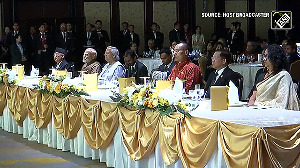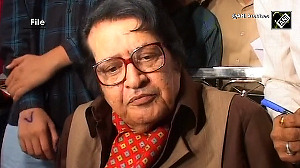Since it was formed 58 years ago, Haryana has had Jat chief ministers for 33 of those.

As candidate selection for the Haryana assembly elections gathers pace -- the state goes to the polls on October 1 and nominations close on September 12 -- some trends are interesting.
To be a candidate you need to fill in a form. The Congress charges Rs 20,000 for every form it sells for an assembly constituency.
However, scheduled caste candidates pay Rs 5,000. So far, the Congress has received 2,556 completed applications, so it has presumably sold more forms.
The party estimates it has earned around Rs 3.5 crore (Rs 35 million) from form sales alone.
The highest number of people wanting to become Congress candidates is from the Nilokheri (reserved for scheduled castes) seat: 88 have applied so far for this seat.
The fewest are in the Garhi Sampla Kiloi constituency: Former chief minister Bhupinder Singh Hooda is the only contender till today.
It is not enough to fill in the form and wait for the call.
Candidates also have to clear an interview with small groups of central party leaders.
Around 100 candidates are being interviewed every day.
Union minister and former Haryana chief minister M L Khattar observed, after a candidate selection meeting, that for every seat, there were 25 to 30 aspirants for nomination by the Bharatiya Janata Party.
State BJP President M L Badoli says around 3,000 names were considered by the party and panels of prospective candidates had been formed for each seat.
It is not clear which of the two numbers is the accurate one.
There is no information available about the number of forms sold by the party.
As for the suitability of candidates, the BJP has done internal surveys and is going by the opinion of party leaders in each district.

And then there's caste. There's always caste. On the face of it, non-Jat caste groups got a voice when the BJP came to power in the state in 2014 and Mr Khattar was made chief minister.
His family was from Pakistan and came to India during Partition.
He devised a bold policy of defeating Jat domination by creating a rainbow coalition, especially of those castes that saw themselves as victims of Jats, like the scheduled castes and other backward classes.

Although the Jat population of Haryana is estimated to be anything between 22 and 27 per cent, the caste's access to land and capital has been the route to political power.
Since it was formed 58 years ago, Haryana has had Jat chief ministers for 33 of those.
Even in 2019, the support of the Jannayak Janta Party, led by Jat leader Dushyant Chautala, saved the day for the BJP.
So, 10 years of BJP rule and the seeming loss of caste prestige have led to a sense of powerlessness.
A manifestation of this frustration was the riots in 2016, which began as a call for Jat reservation and their demand to be treated on a par with OBCs but turned into an attack on symbols of State power like railway facilities and government offices.
But this is not the only problem. The BJP is also facing anti-incumbency, which is showing up in different ways.
Mr Khattar acquired a reputation for being a strict disciplinarian, cracking down hard on institutional corruption at every level.
As part of this drive, the Haryana government's adoption of e-tendering of panchayat level works in 2023, for instance, met with pushback from many, including his colleague and later successor, Nayab Singh Saini.
The policy made it mandatory for a sarpanch to use only the Haryana engineering works portal to tender for projects above Rs 200,000.
Protesting sarpanches said the e-tendering system slowed development works in villages while the government asserted the system was aimed at bringing more transparency and accountability in works.
When he took over, Mr Saini modified this system.
The limit for works that can be done bypassing e-tendering has now been raised to Rs 21 lakh (Rs 2 million).
E-tendering hits at the root of the patronage system.
Jats are predicting a dire future for Dushyant Chautala. Chander Pal, a Jat from Bhiwani who runs a dairy in UP, says if Chautala had asked the khaps (community groups) in 2019 that he was going over to the BJP because he had no option, the community might have endorsed the decision, however reluctantly.
But he crossed over "to the other side" (meaning strengthened non-Jats) taking the Jats for granted.
He asserts it will take many years for Mr Chautala to regain credibility.
Jats and non-Jats alike say many of the initiatives taken by the BJP government are good.
But slights and hurt remain: Like the handling of farmer issues and the prestige of Haryana's girl wrestlers.
August 31 saw the observance of 200 days of farmers' congregations at Delhi-Haryana's Shambhu border.
Some messages from here will inevitably be transmitted to the queues of those who will vote on October 1.
Feature Presentation: Aslam Hunani/Rediff.com












 © 2025
© 2025